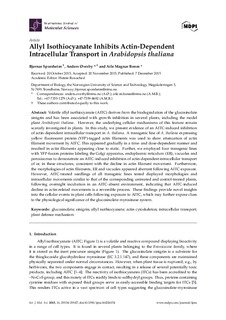| dc.contributor.author | Sporsheim, Bjørnar | |
| dc.contributor.author | Øverby, Anders | |
| dc.contributor.author | Bones, Atle M. | |
| dc.date.accessioned | 2015-12-11T09:59:01Z | |
| dc.date.accessioned | 2016-06-15T06:49:00Z | |
| dc.date.available | 2015-12-11T09:59:01Z | |
| dc.date.available | 2016-06-15T06:49:00Z | |
| dc.date.issued | 2015-12-07 | |
| dc.identifier.citation | International Journal of Molecular Sciences 2015, 16:29134-29147 | nb_NO |
| dc.identifier.issn | 1422-0067 | |
| dc.identifier.uri | http://hdl.handle.net/11250/2392592 | |
| dc.description.abstract | Volatile allyl isothiocyanate (AITC) derives from the biodegradation of the glucosinolate
sinigrin and has been associated with growth inhibition in several plants, including the model
plant Arabidopsis thaliana. However, the underlying cellular mechanisms of this feature remain
scarcely investigated in plants. In this study, we present evidence of an AITC-induced inhibition
of actin-dependent intracellular transport in A. thaliana. A transgenic line of A. thaliana expressing
yellow fluorescent protein (YFP)-tagged actin filaments was used to show attenuation of actin
filament movement by AITC. This appeared gradually in a time- and dose-dependent manner and
resulted in actin filaments appearing close to static. Further, we employed four transgenic lines
with YFP-fusion proteins labeling the Golgi apparatus, endoplasmic reticulum (ER), vacuoles and
peroxisomes to demonstrate an AITC-induced inhibition of actin-dependent intracellular transport
of or, in these structures, consistent with the decline in actin filament movement. Furthermore,
the morphologies of actin filaments, ER and vacuoles appeared aberrant following AITC-exposure.
However, AITC-treated seedlings of all transgenic lines tested displayed morphologies and
intracellular movements similar to that of the corresponding untreated and control-treated plants,
following overnight incubation in an AITC-absent environment, indicating that AITC-induced
decline in actin-related movements is a reversible process. These findings provide novel insights
into the cellular events in plant cells following exposure to AITC, which may further expose clues
to the physiological significance of the glucosinolate-myrosinase system | nb_NO |
| dc.language.iso | eng | nb_NO |
| dc.publisher | MDPI | nb_NO |
| dc.rights | Navngivelse 3.0 Norge | * |
| dc.rights.uri | http://creativecommons.org/licenses/by/3.0/no/ | * |
| dc.title | Allyl isothiocyanate inhibits actin mediated intracellular transport in Arabidopsis thaliana. | nb_NO |
| dc.type | Journal article | nb_NO |
| dc.type | Peer reviewed | nb_NO |
| dc.date.updated | 2015-12-11T09:59:01Z | |
| dc.source.pagenumber | 29134-29147 | nb_NO |
| dc.source.volume | 16 | nb_NO |
| dc.source.journal | International Journal of Molecular Sciences | nb_NO |
| dc.source.issue | 12 | nb_NO |
| dc.identifier.doi | 10.3390/ijms161226154 | |
| dc.identifier.cristin | 1285848 | |
| dc.relation.project | Norges forskningsråd: 214329 | nb_NO |
| dc.description.localcode | © 2015 by the authors; licensee MDPI, Basel, Switzerland. This article is an open access article distributed under the terms and conditions of the Creative Commons by Attribution (CC-BY) license (http://creativecommons.org/licenses/by/4.0/). | nb_NO |

